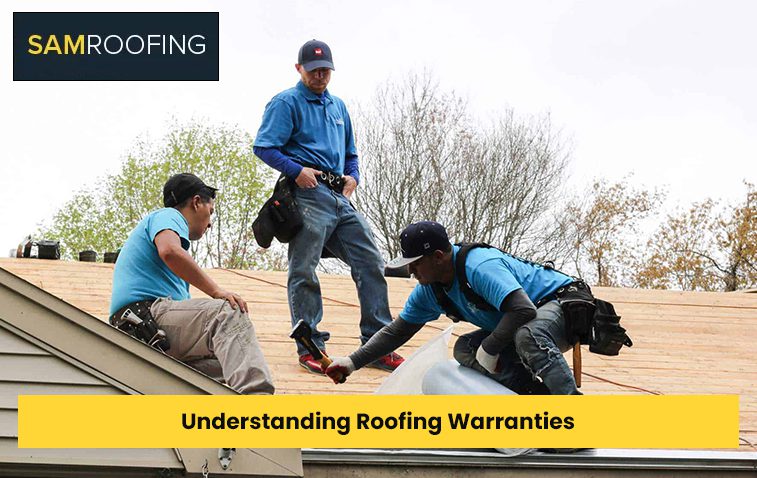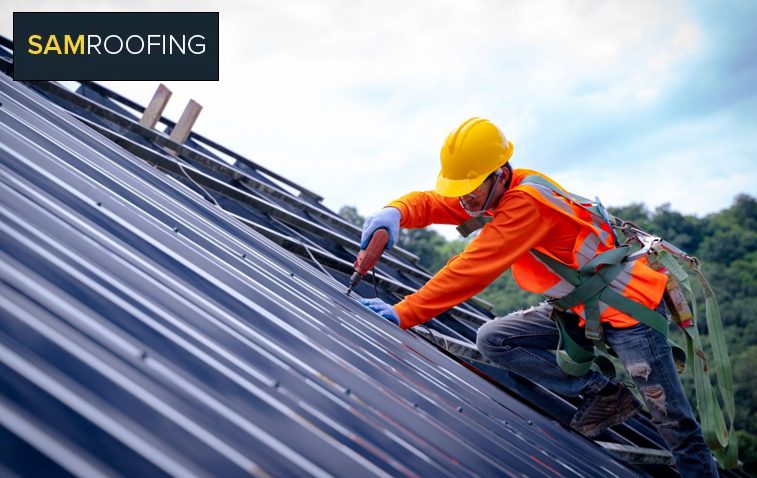Understanding Roofing Warranties: What Homeowners and Business Owners Should Know
A roof is one of the most critical components of any building, providing protection from the elements and contributing to the overall structural integrity of the property. Whether you’re a homeowner or a business owner, investing in a new roof is a significant decision that requires careful consideration. One of the key factors to understand before committing to a roofing project is the warranties that come with it.
Roofing warranties offer peace of mind by covering certain defects and issues that may arise after installation. However, these warranties can vary widely in terms of coverage, duration, and conditions. Understanding the different types of roofing warranties and what they entail is essential to making an informed decision and ensuring that your investment is protected for years to come.

Types of Roofing Warranties
Roofing warranties generally fall into three main categories: manufacturer warranties, workmanship warranties, and extended warranties. Each type offers different levels of coverage and protection.
Manufacturer Warranties
- Coverage of Materials: Manufacturer warranties typically cover defects in the roofing materials themselves. This means if the shingles, tiles, or other roofing materials fail due to a manufacturing defect, the manufacturer will provide replacement materials. However, labor costs for replacing these materials are not always covered.
- Duration: The length of manufacturer warranties can vary, ranging from 20 years to a lifetime, depending on the product. It’s essential to read the fine print, as “lifetime” may mean different things depending on the manufacturer.
Workmanship Warranties
- Coverage of Installation: Workmanship warranties are provided by the roofing contractor and cover issues related to the installation of the roof. If the roof leaks or fails due to improper installation, the contractor is responsible for making the necessary repairs.
- Duration: These warranties typically last between 1 and 10 years. The duration can often reflect the contractor’s confidence in their work, with longer warranties indicating a higher level of trust in the quality of installation.
Extended Warranties
- Additional Coverage: Some manufacturers offer extended warranties that provide additional coverage beyond the standard manufacturer and workmanship warranties. These may include coverage for both materials and labor, as well as more extended periods of protection.
- Cost: Extended warranties usually come at an additional cost but can be worthwhile if you want comprehensive coverage that includes both material defects and installation issues.
Implementation Tips:
- Read the Fine Print: Always carefully read the terms and conditions of any warranty to understand exactly what is covered and what is not.
- Ask Questions: Don’t hesitate to ask the manufacturer or contractor to clarify any points that are unclear. Understanding your warranty is crucial to ensuring you know what protection you have.
Understanding Warranty Coverage
Not all roofing warranties are created equal, and it’s essential to understand what each warranty covers and what it does not.
What Is Typically Covered
- Defects in Materials: As mentioned, manufacturer warranties generally cover defects in the roofing materials. This could include issues such as premature cracking, granule loss, or warping.
- Installation Errors: Workmanship warranties cover installation errors that result in leaks, poor performance, or failure of the roofing system. Common issues might include improper flashing, inadequate ventilation, or incorrect shingle placement.
- Extended Coverage: Extended warranties might cover additional aspects like removal and disposal of defective materials, labor costs for repairs, and sometimes even the cost of a complete roof replacement.
What Is Typically Not Covered
- Normal Wear and Tear: Most warranties do not cover normal wear and tear that occurs over time, such as gradual fading or minor granule loss due to weather exposure.
- Acts of Nature: Damage caused by natural disasters such as hurricanes, tornadoes, earthquakes, or severe storms is usually not covered under standard warranties. This type of damage is typically covered by your homeowner’s insurance.
- Improper Maintenance: If the roof is not properly maintained, this can void the warranty. This includes failing to clean gutters, remove debris, or address minor issues before they become significant problems.
Implementation Tips:
- Maintenance Records: Keep detailed records of all roof maintenance activities, as these may be required to prove that you have maintained the roof properly in the event of a warranty claim.
- Visual Inspections: Conduct regular visual inspections to catch potential issues early and address them before they void your warranty.
Filing a Warranty Claim
If you experience an issue with your roof, it’s crucial to know how to file a warranty claim properly. Understanding the process can help you navigate it smoothly and increase the chances of a successful claim.
Steps to Filing a Claim
- Document the Issue: Take detailed photos and notes of the problem as soon as you notice it. This documentation will be essential when filing your claim.
- Contact the Manufacturer or Contractor: Depending on the type of warranty, you will need to contact either the manufacturer (for material defects) or the contractor (for installation issues). Provide them with all the necessary documentation.
- Follow the Process: Each warranty will have its own claims process, which may include inspections, paperwork, and deadlines. Make sure to follow these steps carefully to avoid having your claim denied.
Common Reasons for Claim Denials
- Failure to Maintain the Roof: If the roof has not been properly maintained, this could be grounds for denying the claim.
- Improper Installation: If a different contractor than the one who provided the warranty did additional work on the roof, this could void the workmanship warranty.
- Expired Warranty: If the warranty has expired, the claim will be denied, so it’s crucial to be aware of the warranty’s duration.
Implementation Tips:
- Timely Claims: File your claim as soon as you notice an issue. Delaying can worsen the problem and may lead to the claim being denied.
- Professional Inspections: Consider having a professional roofer inspect the issue before filing a claim to confirm that it is indeed covered under the warranty.

Avoiding Common Pitfalls
To get the most out of your roofing warranty, it’s important to be aware of common pitfalls that can undermine your coverage.
Misunderstanding Coverage
- Assuming Everything Is Covered: One of the biggest mistakes homeowners make is assuming that a roofing warranty covers everything. It’s essential to read the warranty carefully and understand the limitations.
- Overlooking Maintenance Requirements: Many warranties require regular maintenance, and failing to adhere to these requirements can void the warranty. Make sure you understand and follow any maintenance guidelines.
Improper Installation
- Not Vetting Contractors: Choosing the wrong contractor can result in improper installation, which may not be covered by the warranty. Always ensure that your contractor is licensed, insured, and has a good reputation.
- Skipping Inspections: Regular inspections can catch issues early, but skipping them can lead to small problems growing into major issues that are not covered by the warranty.
Implementation Tips:
- Keep All Documentation: Save all documentation related to your roof, including the warranty, maintenance records, and any correspondence with the manufacturer or contractor.
- Be Proactive: Don’t wait for problems to arise. Be proactive in maintaining your roof and addressing minor issues before they become major problems.
Maximizing Your Warranty Benefits
Maximizing the benefits of your roofing warranty involves more than just understanding the coverage. It requires ongoing attention to your roof’s condition and proactive maintenance.
Regular Inspections and Maintenance
- Annual Inspections: Have your roof inspected annually by a professional to ensure it remains in good condition. Inspections can catch potential issues early, allowing you to address them before they void your warranty.
- Seasonal Maintenance: Perform seasonal maintenance, such as cleaning gutters, removing debris, and checking for damage after storms. This helps prevent problems that could lead to a warranty claim.
Promptly Addressing Issues
- Quick Repairs: If you notice any issues with your roof, such as missing shingles or leaks, address them immediately. Delaying repairs can exacerbate the problem and potentially void your warranty.
- Keeping Records: Maintain a detailed log of all inspections, maintenance, and repairs. This documentation is crucial if you ever need to file a warranty claim.
Implementation Tips:
- Hire Qualified Professionals: Always hire qualified professionals for inspections, maintenance, and repairs to ensure the work is done correctly and doesn’t void your warranty.
- Understand Your Warranty: Make sure you fully understand your roofing warranty, including what is covered, the duration of coverage, and any requirements for maintaining coverage.
Understanding roofing warranties is crucial for homeowners and business owners alike. By familiarizing yourself with the different types of warranties, what they cover, and how to file a claim, you can ensure that your investment in a new roof is protected. Regular roof inspection and proactive management of your roof can help you avoid common pitfalls and maximize the benefits of your warranty. With the right knowledge and approach, you can enjoy peace of mind knowing that your roof is well-covered and that you are prepared for any issues that may arise.